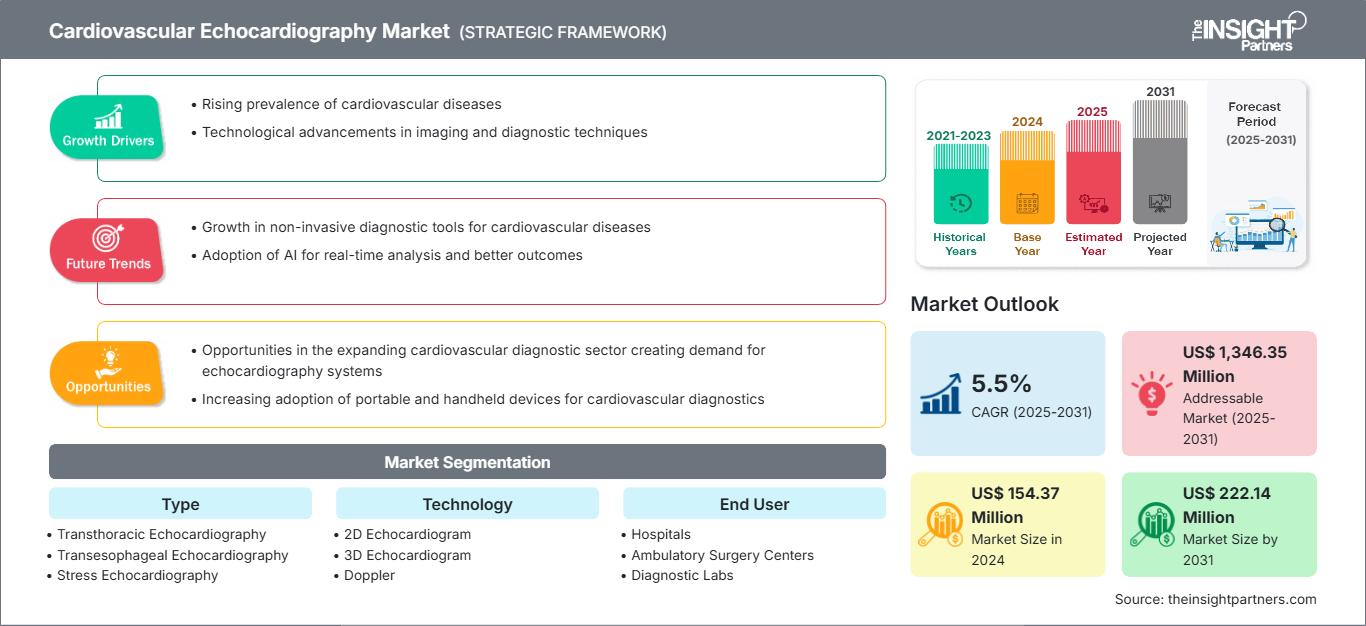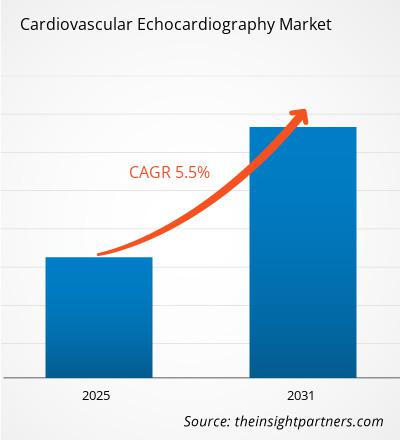[Informe de investigación] Se prevé que el tamaño del mercado de ecocardiografía cardiovascular alcance los 222,14 millones de dólares estadounidenses en 2031, frente a los 154,37 millones de dólares estadounidenses en 2024; se estima que el mercado registrará una tasa de crecimiento anual compuesta (TCAC) del 5,5 % durante el período 2025-2031.
Perspectivas del mercado y opinión de los analistas:
La ecocardiografía cardiovascular es un tipo de imagen médica que se utiliza para examinar el corazón. Emplea ondas sonoras para crear imágenes del mismo. Este procedimiento se suele realizar en pacientes con sospecha o diagnóstico de cardiopatías. Además de revelar el tamaño y la forma de las cavidades y válvulas, la prueba también evalúa la función cardíaca mediante el cálculo del gasto cardíaco, la fracción de eyección y la función diastólica. El ecocardiograma cardiovascular también puede detectar miocardiopatías . Las lesiones derivadas de un infarto previo pueden visualizarse claramente mediante ecocardiografía . La ecocardiografía transtorácica , la transesofágica y la de estrés son algunas de las diversas pruebas de ultrasonido cardíaco que se realizan con fines diagnósticos. Se prevé que la creciente incidencia de enfermedades cardiovasculares y el envejecimiento de la población generen amplias oportunidades para el crecimiento del mercado de la ecocardiografía cardiovascular .
Factores de crecimiento:
Durante la exploración y evaluación de un infarto, dolor torácico, enfermedad arterial coronaria, coágulos sanguíneos y otros trastornos cardíacos, los médicos suelen recomendar tratamientos invasivos que incluyen análisis de sangre y cateterismo cardíaco . El cateterismo cardíaco requiere una hospitalización prolongada y provoca ciertos efectos secundarios como hemorragias, coágulos sanguíneos, daño arterial y otras complicaciones. Por estos motivos, los médicos suelen limitar el uso de este procedimiento para el diagnóstico cardíaco y, en su lugar, recurren a la prueba de esfuerzo cardíaco nuclear, la resonancia magnética, la ecocardiografía y la angiotomografía coronaria , ya que estos procedimientos son mínimamente invasivos .
La ecocardiografía es la prueba diagnóstica cardiovascular más utilizada después del electrocardiograma y la radiografía de tórax. Es un procedimiento diagnóstico no invasivo que proporciona información sobre la función cardíaca y la hemodinámica . Debido a que los riesgos asociados a la ecocardiografía son mínimos o nulos en comparación con otros procedimientos diagnósticos que utilizan radiación, se observa una amplia adopción de estos dispositivos en hospitales y centros de diagnóstico. Además, los pacientes con antecedentes de insuficiencia cardíaca se benefician del seguimiento rutinario mediante estas pruebas diagnósticas. También ayudan a monitorizar la enfermedad y la eficacia del tratamiento o la cirugía. Las ecocardiografías también se utilizan en la atención habitual de pacientes oncológicos con riesgo de cardiotoxicidad .
Las ventajas asociadas al uso de dispositivos ecocardiográficos en comparación con otros procedimientos de diagnóstico cardíaco impulsan su adopción, lo que a su vez impulsa el crecimiento del mercado de la ecocardiografía cardiovascular .
Las tendencias del mercado de la ecocardiografía cardiovascular incluyen la incorporación de IA y otras tecnologías innovadoras en los dispositivos de ecocardiografía .
Obtendrá personalización gratuita de cualquier informe, incluyendo partes de este informe, análisis a nivel de país y paquetes de datos de Excel. Además, podrá aprovechar excelentes ofertas y descuentos para empresas emergentes y universidades.
Mercado de ecocardiografía cardiovascular : Perspectivas estratégicas

-
Obtenga las principales tendencias clave del mercado que se describen en este informe.Esta muestra GRATUITA incluirá análisis de datos, que abarcarán desde tendencias de mercado hasta estimaciones y pronósticos.
Segmentación y alcance del informe:
El análisis del mercado de ecocardiografía cardiovascular se ha realizado considerando los siguientes segmentos: tipo, tecnología, usuario final y geografía. Según el tipo, el mercado se segmenta en ecocardiografía transtorácica , ecocardiografía transesofágica , ecocardiografía de estrés y ecocardiografía fetal . En cuanto a la tecnología, el mercado se clasifica en ecocardiograma 2D, ecocardiograma 3D y Doppler. Según el usuario final, el mercado se categoriza en hospitales, centros de cirugía ambulatoria y laboratorios de diagnóstico. El alcance del informe del mercado de ecocardiografía cardiovascular abarca Norteamérica (Estados Unidos, Canadá y México), Europa (Francia, Alemania, Reino Unido, España, Italia y el resto de Europa), Asia Pacífico (China, Japón, India, Australia, Corea del Sur y el resto de Asia Pacífico), Oriente Medio y África (Arabia Saudita, Sudáfrica, Emiratos Árabes Unidos y el resto de Oriente Medio y África) y Sudamérica y Centroamérica (Brasil, Argentina y el resto de Sudamérica y Centroamérica).
Análisis segmentario:
El mercado de la ecocardiografía cardiovascular, según su tipo, se clasifica en ecocardiografía transtorácica, ecocardiografía de estrés, ecocardiografía transesofágica y ecocardiografía fetal. El segmento de ecocardiografía transtorácica ostentó una importante cuota de mercado en 2022 y se prevé que registre la mayor tasa de crecimiento anual compuesto (TCAC) del mercado durante el período 2022-2030.
Según la tecnología empleada, el mercado se divide en ecocardiograma 2D, ecocardiograma 3D y Doppler. El segmento de ecocardiograma 3D ostentó una importante cuota de mercado en ecocardiografía cardiovascular en 2022 y se estima que registrará la mayor tasa de crecimiento anual compuesto (TCAC) entre 2022 y 2030.
Según el usuario final, el mercado se segmenta en hospitales, centros de cirugía ambulatoria y laboratorios de diagnóstico. El segmento de hospitales ostentó una importante cuota de mercado en ecocardiografía cardiovascular en 2022 y se prevé que registre la mayor tasa de crecimiento anual compuesto (TCAC) durante el período 2022-2030.
Perspectivas regionales del mercado de ecocardiografía cardiovascular
Los analistas de The Insight Partners han explicado en detalle las tendencias regionales y los factores que influyen en el mercado de la ecocardiografía cardiovascular durante el período de previsión. Esta sección también analiza los segmentos del mercado de la ecocardiografía cardiovascular y su distribución geográfica en Norteamérica, Europa, Asia Pacífico, Oriente Medio y África, y Sudamérica y Centroamérica.
Alcance del informe de mercado de ecocardiografía cardiovascular
| Atributo del informe | Detalles |
|---|---|
| Tamaño del mercado en 2024 | 154,37 millones de dólares estadounidenses |
| Tamaño del mercado para 2031 | 222,14 millones de dólares estadounidenses |
| Tasa de crecimiento anual compuesto global (2025 - 2031) | 5,5% |
| Datos históricos | 2021-2023 |
| período de previsión | 2025-2031 |
| Segmentos cubiertos |
Por tipo
|
| Regiones y países cubiertos |
América del norte
|
| Líderes del mercado y perfiles de empresas clave |
|
Densidad de los participantes en el mercado de la ecocardiografía cardiovascular: comprensión de su impacto en la dinámica empresarial
El mercado de la ecocardiografía cardiovascular está creciendo rápidamente, impulsado por la creciente demanda de los usuarios finales debido a factores como la evolución de las preferencias de los consumidores, los avances tecnológicos y una mayor conciencia de los beneficios del producto. A medida que aumenta la demanda, las empresas amplían su oferta, innovan para satisfacer las necesidades de los consumidores y aprovechan las nuevas tendencias, lo que impulsa aún más el crecimiento del mercado.

- Obtenga una visión general de los principales actores del mercado de la ecocardiografía cardiovascular.
Análisis regional:
Geográficamente, el mercado de la ecocardiografía cardiovascular se segmenta en Norteamérica, Europa, Asia Pacífico, Sudamérica y Centroamérica, y Oriente Medio y África. En 2022, Norteamérica acaparó una cuota de mercado significativa. Ese mismo año, Estados Unidos dominó el mercado en esta región. El crecimiento del mercado en Norteamérica se atribuye al aumento de la incidencia de enfermedades cardíacas, al envejecimiento de la población y a la presencia de importantes actores del mercado en la región.
Las enfermedades cardíacas son una de las principales causas de muerte en Estados Unidos. Según los Centros para el Control y la Prevención de Enfermedades (CDC), aproximadamente 805 000 personas sufren un infarto cada año en Estados Unidos. Además, la cardiopatía isquémica es el tipo más común de enfermedad cardíaca, y en 2019 causó la muerte de 360 900 personas. Según los CDC, se estima que 12,1 millones de personas en Estados Unidos padecerán fibrilación auricular en 2030. De manera similar, según el Sistema Canadiense de Vigilancia de Enfermedades Crónicas, aproximadamente 1 de cada 12 adultos canadienses mayores de 20 años (2,6 millones) vive con una enfermedad cardíaca diagnosticada. Según Statistics Canada, 67 399 personas fallecieron a causa de enfermedades cardíacas o accidentes cerebrovasculares en 2020. Por lo tanto, el creciente número de enfermedades cardiovasculares afecta a una población considerable. Esto genera una mayor demanda de herramientas de diagnóstico, como la ecocardiografía cardiovascular, para evaluar y monitorear la salud cardiovascular, lo que impulsa el mercado de la ecocardiografía cardiovascular en la región.
Panorama competitivo y empresas clave:
El pronóstico del mercado de ecocardiografía cardiovascular puede ayudar a las partes interesadas a planificar sus estrategias de crecimiento. Apex Heart and Vascular, Ultra-X Imaging, Metropolitan Heart Vascular Institute, Ultromics Limited, Corewell Health, Centinela Hospital Medical Center, Schoolcraft Memorial Hospital, University of Utah Health, Goshen Heart & Vascular Center y Harefield Hospital se encuentran entre los principales actores analizados en el informe de mercado de ecocardiografía cardiovascular. Estas empresas se centran en la introducción de nuevos productos de alta tecnología, mejoras en los productos existentes y la expansión geográfica para satisfacer la creciente demanda de los consumidores en todo el mundo.
- Análisis histórico (2 años), año base, pronóstico (7 años) con CAGR
- Análisis PEST y FODA
- Tamaño del mercado, valor/volumen: global, regional y nacional
- Industria y panorama competitivo
- Conjunto de datos de Excel
Informes recientes
Testimonios
Razón para comprar
- Toma de decisiones informada
- Comprensión de la dinámica del mercado
- Análisis competitivo
- Información sobre clientes
- Pronósticos del mercado
- Mitigación de riesgos
- Planificación estratégica
- Justificación de la inversión
- Identificación de mercados emergentes
- Mejora de las estrategias de marketing
- Impulso de la eficiencia operativa
- Alineación con las tendencias regulatorias






















 Obtenga una muestra gratuita para - Mercado de ecocardiografía cardiovascular
Obtenga una muestra gratuita para - Mercado de ecocardiografía cardiovascular